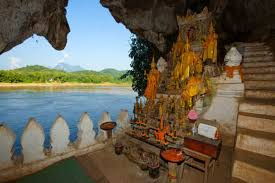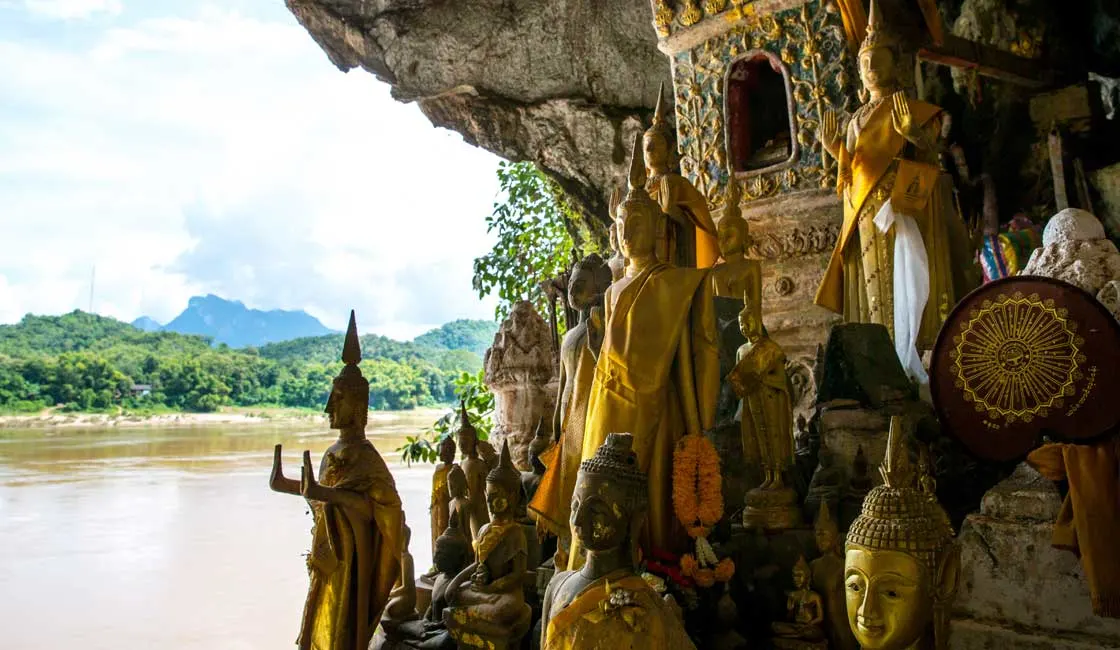Nestled along the banks of the Mekong River in Laos, the Pak Ou Caves stand as one of Southeast Asia’s most revered Buddha sanctuaries. These sacred caves are not just a stunning natural wonder; they are steeped in history and spirituality. With thousands of Buddha statues resting within their limestone walls, each corner tells a story that dates back centuries.
Visiting these caves is like stepping into a living museum where nature and faith intertwine. The serene atmosphere invites travelers to reflect on the beauty of Buddhist culture while marveling at intricate carvings and age-old relics. Whether you’re an avid explorer or someone seeking spiritual solace, the Pak Ou Caves offer an unforgettable experience that resonates long after you’ve left their hallowed grounds. Let’s dive deeper into what makes this destination so special!

Table of Contents
History and Significance of The Pak Ou Caves
The Pak Ou Caves, nestled along the Mekong River in Laos, are steeped in rich history. These sacred Buddha sanctuaries have attracted pilgrims for centuries. Their significance extends beyond mere aesthetics; they represent a vital part of Lao spirituality.
The Mekong River is a vital part of Lao culture, and the Pak Ou Caves are a testament to this. Locals believe that spirits reside in the caves, and they serve as a connection between the earthly and the supernatural realms.

The caves are believed to have been first discovered in the 16th century by King Setthathirath, who was seeking a new capital for the kingdom of Laos. Legend has it that he came across the caves while traveling down the Mekong River and was enchanted by their beauty. He named them “Pak Ou,” which translates to “mouth of the Ou River.”
The caves were initially used as a place of worship for animist and spirit beliefs before Buddhism became prevalent in Laos. Over time, devotees began to bring Buddha images and statues to the caves as offerings, leading to their transformation into a sacred Buddhist site.
At present, there are two main caves at Pak Ou: Tham Ting (lower cave) and Tham Theung (upper cave). These caves house thousands of Buddha images of various sizes and materials, ranging from bronze to wood to gold. These images depict different postures and expressions of Buddha, each symbolizing different aspects of his teachings.
One theory suggests that these Buddha images were brought by worshippers as a form of merit-making or spiritual fulfillment. Another theory suggests that they were placed in the caves to protect them from destruction during times of war.
Today, many locals still visit the Pak Ou C aves to make offerings and seek blessings from the Buddha statues. The caves are also a popular pilgrimage site for Buddhists from all over the world, who come to pay their respects to the Buddha and marvel at the intricate carvings and relics within the caves.
Dating back to the 16th century, these caves became a haven for Buddhist artifacts and statues. They served as both a place of worship and refuge during turbulent times. The sheer number of Buddha images—over 4,000—reflects Laos’s deep-rooted reverence for Buddhism.
Moreover, their location makes them symbolic crossroads between the earthly realm and spiritual enlightenment. Locals believe that visiting these caves brings blessings and protection from misfortune. This enduring belief has kept traditions alive through generations while fostering cultural unity among communities nearby.
As you explore their depths, it’s easy to feel the weight of history pressing down—a palpable connection to those who sought solace within these walls long ago.
Exploring the Lower Cave
As you step into the Lower Cave, a sense of tranquility envelops you. The air is cooler here, inviting exploration and contemplation. This cavern is filled with hundreds of Buddha statues, each one a testament to devotion.
The dim lighting casts gentle shadows on the figures, creating an ethereal ambiance. Some statues are small and intricately carved, while others stand tall and proud. They come in various poses—peaceful meditative stances that resonate deeply with visitors.
Stalactites hang from the ceiling like nature’s chandeliers. As you wander through this sacred space, take time to appreciate both the artistry and spirituality around you.
Locals often leave offerings at the feet of these revered images—flowers, fruits, or incense sticks echoing their prayers and hopes for blessings. Each act adds to the rich tapestry woven over centuries in this hallowed ground dedicated to reflection and reverence.
The Upper Cave: A Journey through Buddhist Art and Culture
The Upper Cave at Pak Ou Caves offers a mesmerizing glimpse into Buddhist art and culture. Stepping inside, visitors are greeted by hundreds of Buddha statues, each telling its own story.
The intricate carvings on the walls showcase ancient craftsmanship that has stood the test of time. The atmosphere is serene, inviting reflection and contemplation.
Sunlight filters through crevices in the rock, illuminating the golden figures scattered throughout. Each statue varies in size and style, representing different periods in Buddhism’s history.
As you wander deeper into this sacred space, you’ll discover niches filled with offerings left by devotees—flowers, incense sticks, and even food items meant for spiritual blessings. It’s a living testament to faith that transcends generations.
This cavernous sanctuary not only reflects religious devotion but also serves as an artistic archive of Laos’ rich cultural heritage. It’s an experience that resonates deeply with both locals and travelers alike.
Rituals and Offerings at Pak Ou Caves
Visitors to the Pak Ou Caves often witness a captivating array of rituals and offerings. Devotees flock to these revered Buddha sanctuaries, bringing with them tokens of respect and gratitude.
The act of placing small statues or images of Buddha within the caves is a common practice. Each offering symbolizes devotion and reverence for the teachings they embody. Many locals believe that these gestures attract blessings and good fortune.

During significant Buddhist festivals, you’ll find mesmerizing ceremonies taking place at the foot of the caves. Monks chant ancient prayers while incense wafts through the air, creating an atmosphere filled with spirituality.
Additionally, travelers can participate in traditional rituals like pouring water over Buddha statues. This simple yet profound gesture signifies purification and renewal—a core aspect of Buddhist beliefs celebrated here in Laos’s sacred spaces.
Ancient History of The Cave
The Pak Ou Caves, carved into limestone cliffs along the Mekong River, have a history that dates back centuries. Their origins trace to the 16th century when they became significant pilgrimage sites for Buddhists in Laos.
Local legends tell of ancient inhabitants who revered these caves as sacred spaces. They believed that spirits resided within their depths, making them ideal sanctuaries for reflection and meditation.
In the 16th century, Laos was under the rule of King Setthathirath, who was a devout Buddhist. He ordered the construction of several temples and religious sites throughout the country, including the Pak Ou Caves. The caves were initially used as a place for worship and meditation by monks and nuns.
Over the centuries, the caves were visited by pilgrims from neighboring countries like Thailand, Cambodia, and Vietnam. These travelers left behind thousands of Buddha statues as offerings, creating a collection that has now become one of the main attractions of the caves.
During times of war and political turmoil in Laos, many Buddha statues were destroyed or stolen from temples and monasteries. The Pak Ou Caves served as safe havens for these sacred objects. It is estimated that there are over 4,000 Buddha statues housed in the upper and lower caves.
The caves also played a role in preserving Buddhism during periods when it was suppressed by invading forces. In the 19th century, when Laos was under French colonial rule, Buddhism faced persecution. Many monks sought refuge in these caves to continue their practices away from prying eyes.
Today, the Pak Ou Caves continue to be important sites for Buddhists in Laos. They are a symbol of the country’s spiritual heritage and a testament to the resilience of its people in preserving their traditions.
As time passed, numerous statues of Buddha accumulated inside the caves. Today, over 4,000 images adorn these hallowed halls. Each statue tells a story of devotion and cultural heritage.
Explorers from different eras marveled at the beauty surrounding these revered Buddha sanctuaries. The blend of natural wonder and spiritual significance captivates those who venture here even now.
Tips for Visiting the Cavesclusion
When visiting the Pak Ou Caves, plan your trip during the cooler months. The weather in Laos can be quite hot, and exploring is much more enjoyable when it’s a bit cooler.
Wear comfortable shoes; the path to the caves can be uneven. You’ll want sturdy footwear for climbing and walking around.
Bring water and snacks along. While there are local vendors nearby, having your provisions ensures you stay hydrated and energized throughout your visit.
Consider hiring a local guide. They provide valuable insights into the history of these revered Buddha sanctuaries that enhance your experience.
Don’t forget to respect the sanctity of this sacred site. Dress modestly and speak softly as you explore these ancient caves filled with spiritual significance.
Capture memories but remember to soak in each moment without being too distracted by technology!
Conclusion
The Pak Ou Caves stand as a testament to the rich cultural tapestry of Laos. Nestled along the Mekong River, these revered Buddha sanctuaries draw visitors from around the globe, each looking to experience their spiritual significance and historical depth.
With more than 4,000 statues residing within their walls, they offer not only a glimpse into Buddhist art but also an opportunity for reflection and reverence.
Visiting these sacred Buddha caves is about more than just sightseeing; it’s an immersive journey into the heart of Laotian spirituality. The rituals performed by locals further enhance this atmosphere, inviting travelers to participate in traditions that have persisted through centuries.
Whether you explore the Lower Cave or ascend to witness the artistic treasures of the Upper Cave, every corner reveals layers of history waiting to be uncovered. As you walk among ancient relics and vibrant offerings left by devotees, there’s a palpable sense of peace that envelops you.
For those planning a visit, taking time to absorb both the beauty and serenity can turn your trip into something truly transformative. The Pak Ou Caves are not merely destinations; they embody a profound connection between past and present—a bridge linking generations through shared beliefs and artistry.
Your adventure at these sacred sites promises memorable experiences while deepening your understanding of Laos’s rich heritage. Each visit nurtures respect for its cultural significance—making any journey here one worth undertaking again and again.
Click here for related details.
Stay tuned on Travelyas for more details.

